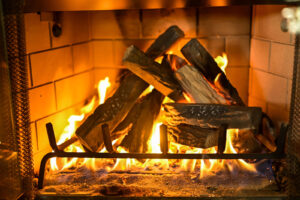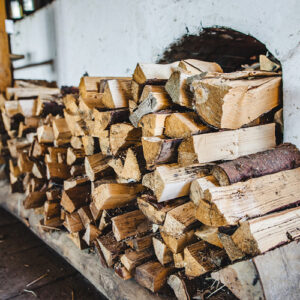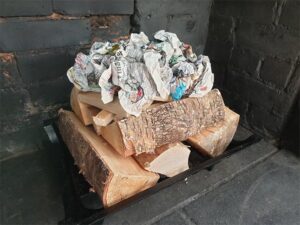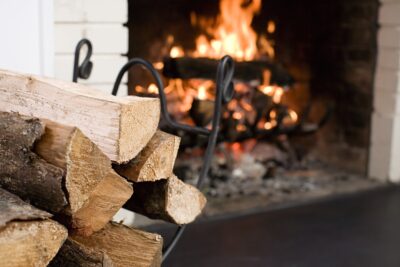Are you tired of struggling to get your fireplace wood burning efficiently? Proper wood stacking might be the key to a warm and cozy fire. We have the right information for you on this page on how to stack wood in fireplace like a pro and enjoy a toasty fire all winter long.
To stack wood in a fireplace, start by placing a layer of kindling or small sticks on the bottom of the fireplace. Next, add larger logs on top of the kindling in a crisscross pattern, leaving space between the logs for airflow.
Finally, add more logs on top of the first layer, stacking them in the same crisscross pattern. Be sure to leave enough space between the logs and the sides of the fireplace to allow for proper ventilation and prevent the fire from spreading.
How to stack wood in fireplace

Stacking wood in a fireplace can be a fun and useful skill to have. Here are the steps you can follow to stack wood in your fireplace:
1. Gather your wood. Make sure you have enough wood to last for the length of time you want to use your fireplace. You can use logs, branches, or other pieces of wood.
2. Choose a spot in your fireplace to stack the wood. This should be a spot that is easy to reach and where the wood will be stable.
3. Begin by placing the largest logs at the bottom of the stack. These will help to support the rest of the wood.
4. Next, add smaller logs on top of the larger ones. You can stack the smaller logs in a crisscross pattern or place them parallel to each other.
5. Continue stacking the wood in this way until you have a pile that is about as high as the opening of your fireplace.
6. Once you have finished stacking the wood, you can light a fire using a match or a lighter. Place the fire starter in the center of the wood pile and light it. Be sure to follow all safety guidelines when lighting a fire.
7. As the fire burns, the wood will eventually burn down to ash. You can use a fireplace tool, such as a poker or shovel, to move the ashes around and keep the fire burning.
8. Remember to always use caution when stacking and lighting a fire in a fireplace. Make sure the fireplace is properly ventilated, and never leave a fire unattended.
How to Properly Stack Wood in a Fireplace for Efficient Burning
Properly stacking wood in a fireplace is essential for ensuring that it burns efficiently and effectively. When wood is stacked incorrectly, it can lead to issues such as poor airflow, smoldering, and incomplete combustion.
To stack wood correctly in a fireplace, follow these steps:
1. First, make sure that you are using dry, seasoned wood. Freshly cut wood contains too much moisture, which can make it difficult to burn and can produce excess smoke and creosote, a flammable byproduct of burning wood.
Seasoned wood, on the other hand, has been properly cured and has had time to dry out, making it easier to ignite and burn more efficiently.
2. Next, arrange the wood in a way that promotes good airflow. One of the key factors in efficient wood burning is the amount of oxygen that is able to reach the fire.
To ensure that oxygen can flow freely, stack the wood in a way that leaves plenty of space between each piece. A pyramid or teepee shape is often recommended, as it allows for plenty of airflow between the logs.
3. Avoid stacking the wood too high or too tightly, as this can restrict airflow and make it more difficult for the fire to burn. Instead, aim for a loose, open stack that allows plenty of oxygen to reach the logs.
4. If you are using a wood stove or insert, make sure to follow the manufacturer’s guidelines for stacking wood. These appliances often have specific guidelines for the size and placement of wood, and following these guidelines can help ensure that the appliance burns efficiently and safely.
Tips for Arranging Wood in a Fireplace to Promote Airflow and Prevent Smoldering
In addition to stacking the wood in a way that promotes airflow, there are a few other tips you can follow to help prevent smoldering and ensure that your fireplace burns efficiently. These include:
1. Use a fire starter or kindling to help get the fire going. These materials are small and easily combustible, and they can help get the fire going more quickly and efficiently.
2. Avoid using too much paper when starting a fire. While a newspaper can be helpful in getting the fire going, using too much of it can restrict airflow and cause the wood to smolder.
3. Make sure the damper is open before starting the fire. The damper is a metal flap that controls the flow of air into the fireplace. If the damper is closed, it can restrict airflow and make it difficult for the fire to burn properly.
4. Regularly remove ashes and debris from the fireplace. As the fire burns, it produces ash and other debris that can accumulate in the fireplace. This debris can restrict airflow and make it more difficult for the fire to burn efficiently. To help prevent this, make sure to regularly remove ash and debris from the fireplace using a shovel or ash bucket.
The Importance of Using Seasoned Wood in a Fireplace
Using seasoned wood in a fireplace is important for a number of reasons. First and foremost, seasoned wood is much easier to ignite and burn than freshly cut wood.
This is because it has had time to dry out and lose much of its moisture content, making it more combustible. In contrast, freshly cut wood can be difficult to ignite and may produce excess smoke and creosote when burned.
Seasoned wood is also more efficient to burn than fresh wood. This is because it contains less moisture, which means it takes less energy to ignite and burn. As a result, you can often get more heat from a smaller amount of seasoned wood than you would from the same amount of fresh wood.
How to Choose the Right Size and Type of Wood for Your Fireplace

When choosing wood for your fireplace, there are a few factors to consider to ensure that you are using the right size and type of wood.
1. Size
The size of the wood you use should be appropriate for your fireplace. If the logs are too large, they may not fit properly in the fireplace and can restrict airflow.
On the other hand, if the logs are too small, they may burn too quickly and may not provide enough heat. In general, logs that are around 18 inches long and 6 inches in diameter are a good size for most fireplaces.
2. Type
Different types of wood have different characteristics and can be better suited for certain purposes. For example, hardwoods such as oak and maple burn more slowly and provide more heat than softer woods like pine and spruce.
Hardwoods are generally considered the best choice for fireplaces because they burn more efficiently and produce less creosote, a flammable byproduct of burning wood. However, softer woods can be a good choice for starting a fire or for use in wood stoves and inserts, where they may burn more efficiently due to their higher moisture content.
Techniques for Stacking Wood in a Pyramid or Teepee Shape for Optimal Burning
One common technique for stacking wood in a fireplace is to arrange it in a pyramid or teepee shape. This type of stack is often recommended because it allows for good airflow between the logs, which can help the fire burn more efficiently.
To stack wood in a pyramid or teepee shape, follow these steps:
1. Begin by placing a few small logs or pieces of kindling in the center of the fireplace. These will serve as the base of the stack.
2. Next, add a layer of larger logs on top of the base, arranging them in a circular pattern around the center.
3. Continue adding layers of logs on top of the first layer, staggering the logs so that they overlap slightly and form a pyramid or teepee shape.
4. Leave plenty of space between each log to allow for good airflow.
Benefits of Using a Wood Rack or Log Holder to Store and Stack Fireplace Wood
A wood rack or log holder is a convenient and practical way to store and stack fireplace wood. These items are designed to hold logs in a way that allows for proper airflow and helps prevent rot and insect infestation. Some benefits of using a wood rack or log holder include the following:
Convenience: A wood rack or log holder keeps your fireplace wood organized and easily accessible, so you don’t have to search for logs every time you want to start a fire.
Protection: Wood racks and log holders help protect your fireplace wood from the elements, keeping it dry and preventing rot. This is especially important if you are storing wood outside or in a damp area.
Safety: A wood rack or log holder can help prevent accidents by keeping logs off the ground and away from pets and children.
Aesthetics: A well-designed wood rack or log holder can also add a decorative touch to your fireplace and help keep your living space looking neat and organized.
How to Properly Store Fireplace Wood to Keep it Dry and Prevent Rot
Properly storing fireplace wood is essential for maintaining the quality and efficiency of your wood-burning fireplace. Proper storage will help to keep the wood dry and prevent it from rotting, which can significantly reduce its heating efficiency.
Here are some tips for properly storing your fireplace wood:
1. Store the wood in a dry and well-ventilated area
This will help to prevent moisture from accumulating on the wood, which can lead to rot. Avoid storing wood in damp basements or covered outdoor areas, as these environments can cause the wood to become wet and prone to rot.
2. Keep the wood off the ground
Stacking the wood directly on the ground can cause it to absorb moisture from the soil, leading to rot. Instead, store the wood on a raised platform or in a wood rack that allows air to circulate around the logs.
3. Cover the wood with a tarp or plastic sheeting
This will help to protect the wood from rain and snow, which can cause the wood to become wet and rot. Make sure that the tarp or plastic sheeting is securely fastened to the wood pile so that it doesn’t blow away in strong winds.
4. Keep the wood pile away from trees and other sources of moisture
Trees can release moisture through their roots, which can cause the wood to become wet and rot. Additionally, keep the wood pile away from sources of water, such as sprinkler systems or gutters, to prevent moisture from accumulating on the wood.
Recommended:
Safety considerations when stacking and arranging wood in a fireplace
Stacking and arranging wood in a fireplace is an important aspect of wood-burning safety. Properly stacking and arranging the wood can help to ensure that the fire burns efficiently and safely, while improper stacking and arrangement can lead to dangerous situations.
Here are some safety considerations to keep in mind when stacking and arranging wood in a fireplace:
1. Stack the wood in a way that allows for proper airflow. The wood should be stacked in a pyramid shape, with the larger logs at the bottom and the smaller logs and kindling at the top. This will allow air to circulate around the logs, which is necessary for proper combustion.
2. Keep the wood stack at a safe distance from the fireplace. The wood stack should be placed at least a few feet away from the fireplace to reduce the risk of fire spreading. This will also allow you to easily access the wood and add more logs to the fire as needed.
3. Use a fireplace grate to hold the wood. A fireplace grate is a metal grid that sits inside the fireplace and holds the wood off the ground. The grate allows air to circulate around the logs, which helps to keep the fire burning efficiently. It also helps to prevent the logs from rolling out of the fireplace and onto the floor, which can be a hazard.
4. Avoid stacking wood too high. Stacking the wood too high can create a fire hazard, as it can obstruct the chimney and prevent proper airflow. Keep the wood stack at a reasonable height and remove any excess wood from the fireplace when it is not in use.
The importance of regularly removing ashes and debris from the fireplace
Removing ashes and debris from the fireplace is an important part of maintaining proper airflow and ensuring the safety of your wood-burning fireplace. Ashes and debris can accumulate in the fireplace over time, obstructing the chimney and reducing the efficiency of the fire.
Here are some reasons why it is important to regularly remove ashes and debris from the fireplace:
1. Maintain proper airflow
Ashes and debris can obstruct the chimney and prevent proper airflow, which is necessary for the fire to burn efficiently. Removing these materials from the fireplace will help to ensure that there is enough air circulation to support the fire.
2. Prevent fires
Ash and debris can catch fire if they come into contact with an open flame or glowing embers. Removing these materials from the fireplace will help to prevent the risk of fire.
3. Reduce the risk of carbon monoxide poisoning
Carbon monoxide is a colorless, odorless gas that is produced when the wood is burned. If the chimney is obstructed by ashes and debris, it can become difficult for the gas to escape, leading to a buildup of carbon monoxide in the home. This can be dangerous, as high levels of carbon monoxide can cause headaches, dizziness, and even death.
4. Improve the efficiency of the fireplace
Removing ashes and debris from the fireplace will help to improve its efficiency by allowing the fire to burn more efficiently. This can save you money on your heating bills and reduce the amount of wood that you need to burn.
How to use fire starters and kindling to help get your fireplace wood burning efficiently
Fire starters and kindling are essential tools for getting your fireplace wood burning efficiently. Fire starters are materials that are designed to ignite easily and provide a steady source of heat until the larger logs catch fire.
Kindling is small, dry wood that is used to start the fire and help it spread to the larger logs.
Here are some tips for using fire starters and kindling to help get your fireplace wood burning efficiently:
1. Use fire starters that are specifically designed for wood-burning fireplaces
These materials are usually made from wax or other flammable substances and are designed to ignite easily and burn for a long time. Some common fire starters include wax fire logs, paper logs, and wood shavings.
2. Use dry, seasoned wood for kindling
Freshly cut wood contains a high amount of moisture, which can make it difficult to ignite. Instead, use dry, seasoned wood for kindling, as it will ignite more easily and burn more efficiently.
3. Create a small fire in the center of the fireplace
Start by placing a few pieces of kindling in the center of the fireplace, and then place a fire starter on top of the kindling. Light the fire starter, and then add a few more pieces of kindling to the fire. Once the fire is burning well, you can add larger logs to the fireplace.
4. Use a fireplace starter tool to help get the fire going
A fireplace starter tool is a long-handled tool that has a small scoop on one end. You can use the tool to scoop up ashes and embers from the fireplace and place them on top of the kindling to help get the fire going.
Benefits of using a wood stove or insert to burn wood in a fireplace

Using a wood stove or insert can provide several benefits when it comes to burning wood in a fireplace. Wood stoves and inserts are designed specifically for wood-burning, and they are generally more efficient and easier to use than traditional fireplaces.
Here are some benefits of using a wood stove or insert to burn wood in a fireplace:
1. Increased efficiency
Wood stoves and inserts are typically more efficient than traditional fireplaces, as they are designed specifically for wood burning. This means that they can burn wood more efficiently, resulting in less smoke and more heat.
2. Easy to use
Wood stoves and inserts are generally easier to use than traditional fireplaces, as they have simple controls and do not require the use of a grate or poker. This makes it easier to start and maintain the fire, and it also reduces the risk of accidents.
3. Better heat distribution
Wood stoves and inserts are designed to radiate heat in all directions, which means that they can heat a room more evenly than a traditional fireplace. This is especially useful for large rooms or open floor plans, where it can be difficult to get even heat distribution from a traditional fireplace.
4. Safety features
Many wood stoves and inserts come equipped with safety features such as airtight doors and thermal glass windows, which can help to reduce the risk of fires and accidents. These features can provide added peace of mind when using the stove or insert.
How to properly maintain and clean your fireplace and wood-burning equipment to ensure safe and efficient use
Proper maintenance and cleaning of your fireplace and wood-burning equipment are essential for ensuring safe and efficient use.
Here are some tips for properly maintaining and cleaning your fireplace and wood-burning equipment:
1. Regularly inspect the chimney
The chimney is an important component of your wood-burning system, as it helps to vent smoke and gases outside of the home. It is important to regularly inspect the chimney for signs of damage or blockages, as these can hinder the efficiency of the fireplace and increase the risk of fires.
2. Clean the fireplace regularly
Ashes and debris can accumulate in the fireplace over time, which can obstruct the chimney and reduce the efficiency of the fire. It is important to clean the fireplace regularly to remove these materials and maintain proper airflow.
3. Use a fireplace screen
A fireplace screen is a metal or meshes barrier that is placed in front of the fireplace to prevent sparks and embers from escaping. This can help to reduce the risk of fires and accidents, and it can also help to keep the room clean and free of ashes and debris.
4. Use proper wood-burning equipment
It is important to use proper wood-burning equipment, such as a fireplace grate and poker, to ensure the safety and efficiency of your wood-burning system. Using the wrong equipment or using equipment that is in poor condition can increase the risk of accidents and reduce the efficiency of the fireplace.
5. Follow proper wood-burning techniques
It is important to follow proper wood-burning techniques to ensure the safety and efficiency of your fireplace. This includes stacking the wood in a pyramid shape to allow for proper airflow, using dry, seasoned wood, and starting the fire with fire starters and kindling.
By following these tips, you can help to ensure that your fireplace and wood-burning equipment are properly maintained and used safely and efficiently.
Conclusion
Stacking wood in a fireplace involves gathering enough wood, choosing a spot in the fireplace to stack it, placing the largest logs at the bottom and adding smaller logs on top, and lighting the fire using a match or lighter.
It’s important you know how to stack wood in fireplace and also follow all safety guidelines when stacking and lighting a fire in a fireplace, and never leave a fire unattended. With these steps in mind, you can easily stack wood in your fireplace and enjoy the warmth and ambiance it provides.

